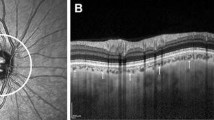Abstract
Purpose
To investigate the relationship between peripapillary choroidal thickness (PCT) and choroidal vascular prominence (CVP) colocalized with retinal nerve fiber layer (RNFL) defect in primary open-angle glaucoma (POAG) eyes and to evaluate the relationship between PCT and POAG severity.
Methods
In this cross-sectional comparative study, 29 POAG patients with CVP on RNFL imaging (Group A), 70 POAG patients without CVP (Group B) and 63 healthy controls (Group C) were examined. Various factors including age, intraocular pressure (IOP), spherical equivalent (SE), axial length (AXL), central corneal thickness (CCT), peripapillary RNFL thickness, visual-field mean deviation (MD) and pattern standard deviation (PSD) were investigated. Also, PCT (average, clock-hour) was measured by swept-source optical coherence tomography. The differences in each of the factors were analyzed among the groups.
Results
There was no significant difference in age, IOP, SE, AXL or CCT among the three groups (P > 0.05). MD, PSD and RNFL thickness (RNFLT) in Groups A and B were lower than in Group C, but there was no difference between Groups A and B. There was a significant difference in adjusted PCT between Groups A and B (79.39 ± 6.56 vs. 115.87 ± 4.25, P < 0.001). Every adjusted clock-hour PCT in Group A was significantly thinner than in Group B.
Conclusions
CVP in red-free RNFL images indicated severe thinning of PCT. Although PCT thinning was not related to glaucoma severity, CVP in red-free RNFL images should be observed as an indicator of PCT thinning, associated with POAG.




Similar content being viewed by others
References
Sarks SH. Senile choroidal atrophy. Aust J Ophthalmol. 1974;2:57–63
Roberts KF, Artes PH, O’Leary N, Reis AS, Sharpe GP, Hutchison DM, et al. Peripapillary choroidal thickness in healthy controls and patients with focal, diffuse, and sclerotic glaucomatous optic disc damage. Arch Ophthalmol. 2012;130:980–6.
Yan YN, Wang YX, Xu L, Xu J, Wei WB, Jonas JB. Fundus tessellation: prevalence and associated factors: The Beijing Eye Study 2011. Ophthalmology. 2015;122:1873–80.
Hirooka K, Tenkumo K, Fujiwara A, Baba T, Sato S, Shiraga F. Evaluation of peripapillary choroidal thickness in patients with normal-tension glaucoma. BMC ophthalmol. 2012;12:29.
Usui S, Ikuno Y, Miki A, Matsushita K, Yasuno Y, Nishida K. Evaluation of the choroidal thickness using high-penetration optical coherence tomography with long wavelength in highly myopic normal-tension glaucoma. Am J Ophthalmol. 2012;153:10–6.
Park HY, Lee NY, Shin HY, Park CK. Analysis of macular and peripapillary choroidal thickness in glaucoma patients by enhanced depth imaging optical coherence tomography. J Glaucoma. 2014;23:225–31.
Sullivan-Mee M, Patel NB, Pensyl D, Qualls C. Relationship between juxtapapillary choroidal volume and beta-zone parapapillary atrophy in eyes with and without primary open-angle glaucoma. Am J Ophthalmol. 2015;160:637–47.
Hayreh SS. The blood supply of the optic nerve head and the evaluation of it—myth and reality. Prog Retin Eye Res. 2001;20:563–93.
Ehrlich JR, Peterson J, Parlitsis G, Kay KY, Kiss S, Radcliffe NM. Peripapillary choroidal thickness in glaucoma measured with optical coherence tomography. Exp Eye Res. 2011;92:189–94.
Maul EA, Friedman DS, Chang DS, Boland MV, Ramulu PY, Jampel HD, et al. Choroidal thickness measured by spectral domain optical coherence tomography: factors affecting thickness in glaucoma patients. Ophthalmology. 2011;118:1571–9.
Hosseini H, Nilforushan N, Moghimi S, Bitrian E, Riddle J, Lee GY, et al. Peripapillary and macular choroidal thickness in glaucoma. J Ophthalmic Vis Res. 2014;9:154–61.
Lee SH, Lee EJ, Kim TW. Topographic correlation between juxtapapillary choroidal thickness and microstructure of parapapillary atrophy. Ophthalmology. 2016;123:1965–73.
Zhang Z, Yu M, Wang F, Dai Y, Wu Z. Choroidal thickness and open-angle glaucoma: a meta-analysis and systematic review. J Glaucoma. 2016;25:446–54.
Yoshihara N, Yamashita T, Ohno-Matsui K, Sakamoto T. Objective analyses of tessellated fundi and significant correlation between degree of tessellation and choroidal thickness in healthy eyes. PLoS ONE. 2014;9:e103586.
Wang W, Zhang X. Choroidal thickness and primary open-angle glaucoma: a cross-sectional study and meta-analysis. Invest Ophthalmol Vis Sci. 2014;55:6007–14.
Author information
Authors and Affiliations
Corresponding author
About this article
Cite this article
Song, Y.J., Kim, Y.K., Jeoung, J.W. et al. Assessment of peripapillary choroidal thickness in primary open-angle glaucoma patients with choroidal vascular prominence. Jpn J Ophthalmol 61, 448–456 (2017). https://doi.org/10.1007/s10384-017-0535-8
Received:
Accepted:
Published:
Issue Date:
DOI: https://doi.org/10.1007/s10384-017-0535-8




